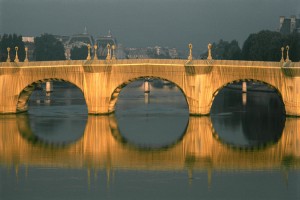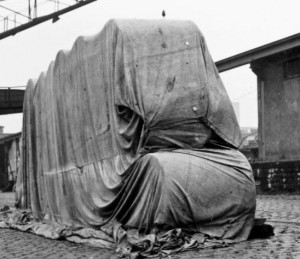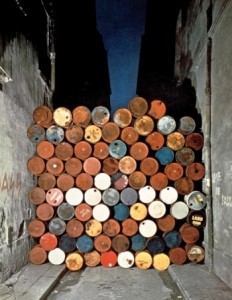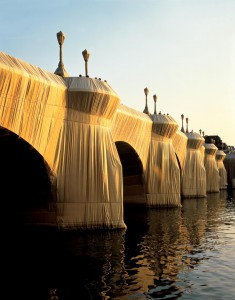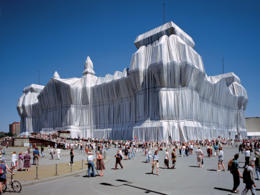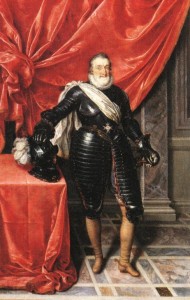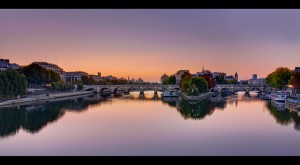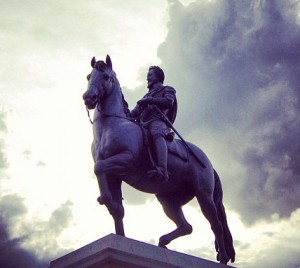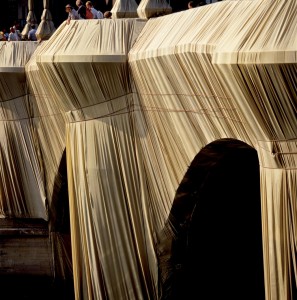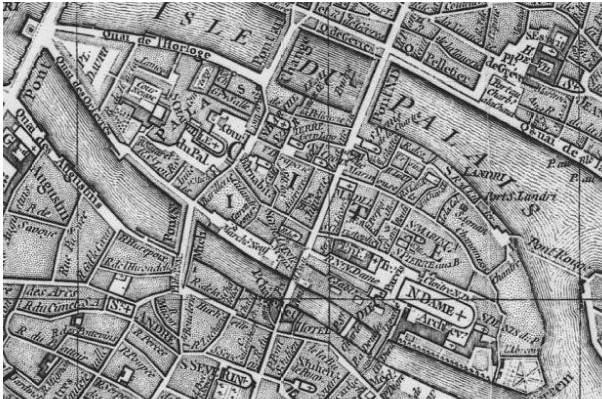
I Feel Like the New Bridge: A Geo-Historical Analysis Christo and Jeanne-Claude’s, “Le Pont Neuf Wrapped,” 1975-85 by Megan Koboldt
“Never did anyone look at the Pont Neuf as much as the day it was hidden… Christo teaches us to see.”—Jack Lange, Minister of Culture. (I)
Christo and Jeanne-Claude’s site specific and temporary installations both in the public environment as well as with in the confines of the gallery provide a tactile, accessible experience for the general public. The work is universal in appeal, but it often raises heated questions about the use of public space and objections from authorities and their constituents. Site installations provide the viewer with a different visual experience that transforms and transcends expectations so that landmarks are viewed as art objects instead of mere tourist destinations. Christo and Jeanne-Claude’s installation, “Le Pont Neuf Wrapped” 1975-85, creates an immediate accessible entry way into French Renaissance history and contemporary French politics on an epic, massive scale. “Le Pont Neuf” itself is an iconic symbol of French political and religious unity and Christo and Jeanne-Claude appear to be using the forms and cultural/historical associations of the bridge to comment on and even heal political turmoil suffered in France during the 1960’s and 1970’s.(II) The wrapping itself becomes a metaphor for building society together through art.
In the 1960s Christo and Jeanne-Claude began wrapping objects during a time in Europe when France was wracked with conflict.(III) Many of their early installations, “Stacked Oil Barrels and Dockside Packages” 1961, “Wall of Oil Barrels- The Iron Curtain” 1961-62, “Le Pont Neuf Wrapped” 1975-85, and “Wrapped Reichstag” 1971-95 often reference political conflict and unrest spread throughout Europe; the beginning of OPEC (Organization of Petroleum Export Countries), division and creation of the Berlin Wall and the social revolutions of the 1960s and 1970s. Each temporary installation altered the entire space, altering aesthetic quality uncommon in public art, and giving the work a life of its own. “Le Pont Neuf Wrapped” is one of the artist’s most notorious installations that took the artists ten years of bureaucratic negotiations, arguments, and approval to finally make a reality.(IV)
The 405-year-old “Pont Neuf” stands as Paris’s oldest bridge, taking a central part in Parisian culture for centuries. Its birth spanned three decades of political unrest and religious turmoil, a period to which the bridge is associated with today.(V) Henry IV, or Henry of Navarre, became king bringing religious and political harmony back to French citizens after years of war between the Catholic and Huguenot sectarian factions. Henry IV’s was admired by the French and his political leadership skills have been carved into history through the designs and life of the Pont Neuf. His signature equestrian statue still stands upon the bridge, in remembrance of Henry but also as a symbol of the unity the bridge brought to the people, a symbol for them to evolve and rise up from inequality and hate.
The construction of the bridge is continuous. Over time each stone and arch has been replaced and preserved by many generations. The original design by Jean Baptiste Androuet du Cerceau, was completed in 1607 under Henry IV’s direction and supervision.(VI) He promoted agriculture and education, regularized state finances, and encouraged the arts; the “Pont Neuf” embodies much of his reforming zeal. Henry’s stabilization of France gained long lasting respect in France and this is manifested on the “Pont Neuf” with various monuments to Henry.(VII)
Stretching across the Seine River, “Le Pont Neuf” reaches 761 ft. in length 72 ft. wide, connecting Parisians to the Ile de Cite, the ritual city of Paris. Composed of two separate spans, one of five and the other of seven arches, joining the left and right banks of the river together. (Op. cit., Volz, pg. 13.) In the present era, the bridge is still used as a prime source of transportation, inviting the public to interact with it regularly as pedestrians, commuters and site seers. The Ile de Cite is a natural island of the Seine River, housing “Notre Dame” cathedral, “The Daulphine palace,” “Prefecture de Police,” “Palais de Justice,” and Hotel Dieu hospital-the administrative ecclesiastic beating heart of France itself.
The visual impact of “Le Pont Neuf Wrapped” interrupted the normal state of the bridge. The wrapping process reveals geometric shapes and angles that symbolize the idea of a bridge which connects geographical units and peoples. It is tempting to see Christo and Jeanne-Claude’s habitual process of wrapping and covering objects like “Le Pont Neuf,” as if they are conserving and healing the object. The selection of the object and technique of the wrapping transforms the outside environment into an over-sized blank canvas, transforming the functional architecture into an object of contemplation, as well as a novel re-interpretation of the original purpose of the structure. The created drapery idealizes the bridge and the act of draping is referred to in Hegel’s theory of aesthetics as important.(VIII)
Christo and Jeanne-Claude’s use of the silk-like polyamide material heightens the lines and shape features of the bridge. The fabric creates a pleated texture pattern in the wrapped piers and capitals. The fabric gathers to accentuate points on the bridge, like separating couture design with elegant proportions into smoothly draped sections that define the curvilinear silhouette of a feminine figure. This organizes the architectural elements of the platform and the arches into a symmetrical, stretched structure that unifies the engineering and the ornamental features of the bridge, bringing out the forms and hiding the blemishes. The shiny polyamide fabric heightens the eye-catching element of the arches and piers, tricking the eye into seeing an almost cylindrical shape. The crowns of the columns extend and drop to a lesser circumference at the base making the outline of the bridge flow in a smooth manner from the top into the river below. The formal elements of “Le Pont Neuf’s” cylindrical piers, circular capitals and smooth arches give the whole composition a clean and organized yet liquid metallic outline. The light posts, banisters, and equestrian statue wrapped together form an enormous, temporary form.
The material was appropriate for the “city of light,” creating a variety of light effects. The sand colored metallic fabric interacted with the outside environment in a variety of ways during different times of the day. Daylight kept the liquid look of the fabric at bay, almost making the wrapping look similar to muted sand stone. During the night hours, “Le Pont Neuf” became illuminated with amber light that transformed the surface revealing a feminine hourglass figure. The lighting element of this environmental installation highlights the symbolic and transformative effects on the structure of the bridge. “Drapery enhances the organic beauty of the form, idealizes it, and hides its imperfections. The focus on the form within, not the ornamentation itself.”(IX) The use of a public space and drapery allows the viewer to interact with the piece from different angles and perspectives, transforming the view of “Le Pont Neuf” into an unfamiliar and new structure, potentially even changing the perception of the bridge long after the wrapping is removed. Christo and Jeanne-Claude’s works are temporary but the memories often remain for years.(X)
The wrapping, along with the rope and construction constitute the many elements of connective signs that makes the piece an organic form, containing a skeletal structure, ligaments and muscle. The underlining engineering of the bridge form the bones, the ropes resemble tendons and ligaments, and the fabric stretches over the whole to become the skin of the bridges new sculpture. The ropes or ligaments, accentuate the capitals separating the piers into defined almost anatomically, but also unites the wrapping to the bridge. The overall composition unites the Seine River and “Le Pont Neuf” optically. The reflection of the structure on the shimmering surface of the river shows how the installation changes the entire environment around it. Christo and Jeanne-Claude are highly sensitive to the wider environment. The reflection of the structure not only reflects the image but also represents why Christo and Jeanne-Claude chose “Le Pont Neuf.” The wrapping is effectively a cast, molded specifically for “Le Pont Neuf” and its viewers. Perhaps this “cast” tells us something about France after the post-colonial and civil strife of the 1960’s and 1970’s and can be seen as a continuation of the original “Le Pont Neuf’s” intent to bind French society together through art. The reactions to the work were often quite outspoken and became part of the work.
“Le Pont Neuf Wrapped” has been compared to a body by other writers in the context of superficial fashion, both discuss the wrapping as a direct relation to the function of clothing being a boundary between the intrinsic self and body it surrounds and the outside world. Salinger discusses how unique “Le Pont Neuf Wrapped” was and cannot be discussed easily without talking about the bridges connection to Paris and its public identity. Dress (or wrapping) becomes a part of the creation of identity, linking the biological body to the social, going from private to public. Acting as the mirror to hold up the psychological shaky self, constantly being redefined in light of its reflection in society however this comparison to the body brings up the issue of wrapping as protection, clothes, even fashionable ones are a way to protect the body. (Op. cit. Salinger, 7)
This reading of the wrapping’s protective process is especially pertinent in the context of the French phrase: “I feel like the Pont Neuf” “comme Pont Neuf” which can either mean “I feel at death’s door” or “I’m mended.” The wrapping becomes a cast. Every French person understands that death and regeneration are referred to in this one phrase with a double entendre that uniquely refers to this bridge and the ongoing process of repairing the bridge stone by stone. Christo’s motivation for wrapping the bridge is not dissimilar to the care and attention the bridge regularly requires anyway. The wrapping process and exhibition which lasted for only 14 days directly references both this process of continual repair and regeneration as an extension of the life of the body of the bridge itself and in the linguistic meaning of the French phrase. One Parisian even spent so much time “feeling” the bridge by lovingly running her hands up and down the fabric that she forgot she was still on a functional bridge and she was run over by a car. In her particular case she took the idea of “feeling like the bridge” literally.
Shortly before Christo and Jeanne-Claude created this installation, France was recovering from the Vichy period in WWII, the Indochina war, and the more recent Algerian conflict.(XI) Ten years after WWII ended, the Algerian revolution began, bringing France itself to the brink of civil war. Civilian and military forces on both sides, clashed in the streets eventually leading to the independence of Algeria and the fall of the Fourth Republic of France. Charles de Gaulle,(XII) a retired French military officer, founded the Fifth Republic of France which restored order and began a new era of restoration and growth. The wrapping process as used by Christo and Jeanne-Claude obliquely refer to the national healing process, it is no accident that “Le Pont Neuf” was chosen as the site to wrap.
Christo and Jeanne-Claude’s choice and placement of the wrapping on “Le Pont Neuf” illustrate an intention: “The concealment caused by the fabric challenges the viewer to reappraise the objects beneath and the space in which it exists.”(XIII) “The artists thought it was innovative to wrap up the Pont-Neuf. But they weren’t aware that for many centuries its stone arches had been enveloped in the folds of Parisian institutions, without which it would have collapsed a long time ago.”(XIV) This, along with a variety of different pieces of information, comments on how “Le Pont Neuf” is in itself a living being within Parisian culture. That it is passed down through generations and has ownership over the people of the city and the people of Paris have ownership over it. The never-ending access to the bridge any time of day, gave artists the opportunity to interact with a larger audience and provide the viewer a renewed experience of the iconic bridge through simplifying the aesthetic qualities. The wrapping hid the bridge’s identifying features which left the installation room to wipe previous perceptions of the bridges slate clean and metaphorically mend the cracks made during the wars. (Op.cit. Latour and Hermant, 99) These sorts of intentions are denied by Christo and Jeanne Claude as they claim the wrapping is just an aesthetic exercises. However their other alterations with monuments are quite telling.
Through the act of wrapping, a metaphor for French society, Christo and Jeanne Claude’s installation connects with the fundamental idea of Henry IV’s “Le Pont Neuf,” binding society together and healing scars. Christos intent can be seen not only with “Le Pont Neuf Wrapped,” but also the “Wrapped Reichstag,” 1971-95. The Reichstag was built in 1894, destroyed by arson in 1933,(XV) almost destroyed in 1945 and restored in the 1960s, has become a symbol of democracy denied.(XVI)The destruction of the Berlin Wall and reunification of Germany allowed Christo and Jeanne-Claude to realize the project to wrap the building with a protective layer of fabric that brought awareness and importance to the democratic icon in Germany and the world.
Christo and Jeanne-Claude’s universal appeal has brought attention to not only the use of public space but also has transformed landmarks like “Le Pont Neuf,” into contemporary art works that bring value to public art. The creation of “Le Pont Neuf Wrapped” shows the many layers of the artists love story with not only each other, but within art. Christo and Jeanne-Claude’s experiences through their childhood, Christo’s Bulgarian citizenship being stripped away and Jeanne-Claude’s experience as a military child. The refugee of the Cold War heading west to freedom and the child of a military officer make a symbolic cast over the bridge that unifies the personal and historical relationship.(XVII) Jeanne Claude is a daughter of the French establishment and Christo is an adopted son.(XVIII)
The wrapping’s massive scale and epic 14-day installation revealed a unique point of view about Paris and its historical identity. The whole environment around “Le Pont Neuf” changed and brought awareness to the parallels between the past and present. Residents and visitors from all over the world were prompted toward introspection, contributing to a legacy that still is associated with the bridge today. Jeanne-Claude commented on their work that:
“The temporary character of the work of art creates a feeling of fragility, vulnerability, and an urgency to be seen, as well as a presence of the missing, because we know it will be gone tomorrow. The quality of love and tenderness that human beings have towards what will not last, for instance the love and tenderness for childhood and our lives, is a quality we want to give our work.(XIX)
The juxtaposition of permanence and temporal almost seems as if it is the true subject of the duo’s work. The importance of conserving “Le Pont Neuf” and the love of the “what will not last” shows the transformation of “Le Pont Neuf” from a bridge to a living, breathing body.
Notes
I Jack Lang was the Minister of Culture in France during 1981-86 and 1988-1992. Credited for creating the “Fete de Musique,” a massive celebration of music held annually on 21 June. Created the Lang Law, allowing publishers to enforce a minimum sale price for books. Lang commented on the Maysles Brothers film, Christo in Paris, 1986.
II France experienced a period of civil infighting and military operations from 1562 to 1598, during which Catholic and Protestants fought over factional disputes between the house of Bourbon and the house of Guise. The Saint Bartholomew’s Massacre occurred on the wedding day of Protestant Henry of Navarre and Catholic princess Marguerite de Valois. Killing spread over the next five days and eventually to other cities. The 1960’s were marked by various civil and societal upheavals notably the riots of 1968 and the turnover of the republics (Baird, 426-494).
III Rabia Bekkar, “Algerian War of Independence,” p. 136-138.
IV Volz, Wolfgang et. Al. “Christo: the Pont Neuf Wrapped,” Paris, p. 11.
V Henry IV became king of France in 1589-1610. Originally, Henry of Navarre, a relative of the Protestant House of Bourbon, a royal French family. When Henry III died, Henry of Navarre became king and ended the War between the Huguenot’s and Catholics. As Catholicism the traditional religion of France, Henry gave freedom to Protestants by enacting the Edict of Nantes (Holt, p. 153-189).
VI Whiteney, “Bridges of the World: Their Design and Construction,” p.135-138.
VII De la Croix, “The Lives if the Kings and Queens of France,” 175-182.
VIII Inwood, “Introductory Lectures on Aesthetic,” 146-49.
IX Salinger “The Pont Neuf Wrapped: Framing the Bridge, Bridging the Frame,” p. 10-11.
X Many political advisors were against the public monument, thinking that the public would not believe that the project wasn’t from tax payers rather than the artists themselves. Claude Pompidou, wife of former President George Pompidou, being a friend of Jeanne Claude, sent letters on behalf of Christo and Jeanne Claude to Jacque Chirac for installation approval. Chirac absentmindedly signed the approval after an assistant secretly slipped the form within a stack of papers (Volz, et. Al.,
p. 120).
XI Vichy was a regime of French government that aided Axis powers in WWII. Marshall Philippe Petain, lead the group who assisted the German occupying forces in getting rid of Jewish citizens and other “undesirables”. ( Bekkar, 137)
XII Charles de Gaulle was a decorated French Military officer who served in WWI and WWII and later became President of France after the fall of the fifth republic in 1958. (Spartacus, 2012)
XIII Adam Thomas Blackbourn, 2011, quoted on Christo and Jeanne Claude’s site
XIV Bruno Latour and Emilie Hermant Paris and its ownership in, Paris: Invisible City. Latour is a French sociologist and Hermant combined words and images to capture all of Paris in a single glance, which is said to be impossible to the point it becomes invisible, p.99.
XV The Reichstag is now the German Parliament building in Berlin. During WWII the building was unoccupied due to the dissolvent of Parliament and the 1933 fire that was set after Hitler became Chancellor of Germany. No one knows who set the fire. In any case it was a symbol of failed German Democracy. (Christo and Jeanne Claude, 2012)
XVI “Wrapped Reichstag,” Christojeanneclaude.net
XVII Jeanne Claude was the daughter of, Major Leon Denat. During WWII. She was sent to live with her grandparents due to one in the military and the other involved in the French Resistance. (Christo and Jeanne Claude, 2012)
XVIII Christo and Jeanne Claude were both born on June 13, 1935. Christo was born in Bulgaria and Jeanne Claude born in Casablanca, Morocco. They met in 1958 in Paris, France. Jeanne Claude graduated from the University of Tunis in 1956 with a Baccalaureate in Latin and Philosophy. Christo went to art school in Sofia, Bulgaria at the Fine Arts Academy and the Fine Arts Academy in Vienna, Austria. In 2009, Jeanne Claude passed away due to a brain aneurysm. (Christo and Jeanne Claude, 2012)
XIX Newman, “Christo and Jeanne-Claude Unwrapped.”
Sources
Baird, Henry Martyn, “History of the rise of the Huguenots of France,” NY: AMS Press. http://www.gutenberg.org/files/22762/22762-h/22762-h.htm, 1970.
Barnes H. “Wrapping Up the Story of Artist and Paris Bridge.” St. Louis Post – Dispatch: Pulitzer, Inc.; E3,1991.
Bekkar, Rabia, “Algerian War of Independence” in the “Encyclopedia of Modern Middle East and North Africa,” edited by Phillip Mattar, Mcmillian Reference USA, 2004.
“Charles de Gaulle” spartacus.schoolnet.co.uk/2WWdegaulle.htm. Accessed November 2, 2012
‘Christo and Jeanne-Claude’ accessed on October 1, 2012, christojeanneclaude.net
de La Croix, René, Duc de Castries, “The Lives of the Kings & Queens of France,” Alfred A. Knopf: New York, 1979.
Grande, John K., “Christo and Jeanne-Claude: World Wrap.” Vie Des Arts, p. 48.
Guthmann , E. ‘Christo in Paris’ by Maysles Brothers, San Francisco Chronicle, San Francisco, CA: Hearst Communications Inc., Hearst Newspapers Division; 1991:E3
Hegel, Georg Wilhelm Freidrich, “Introductory Lectures on Aesthetics,” 1993. Trans. Bernard Bosquet. Ed. Michael Inwood. London: Penguin books,1993.
Hoelterhoff, Manuela, 2009.” Jeanne-Claude—Christo’s Dynamic Muse” Bloomberg, November 20, 2009. (accessed Nov. 21, 2012).
Hogue, Martin, “The Site as Project: Lessons from Land Art and Conceptual Art.” Journal Of Architectural Education, 57, no. 3 (February, 2004).
Holt, Mack P., :The French wars of religion,” 1562-1629. Cambridge [England]: Cambridge University Press,1995.
Latour, Bruno and Hermant Emilie, “Paris: Invisible City,” France. bruno-latour.fr/sites/default/files/downloads/viii_paris-city-gb.pdf
Newhouse, Victoria, “Art and the Power of Placement,” NY: The Monacelli Press Inc., 2005.
Newman, Cathy, “Christo and Jeanne Claude Unwrapped” National Geographic, November 2006. (accessed December 10, 2012). ngm.nationalgeographic.com/ngm/0611/voices.html
Salinger, Victoria, “The Pont Neuf Wrapped: Framing the Bridge, Bridging the Frame.” PH.D Diss., Bryn Mawr College, Pennsylvania, 2007.
Thomas, Selma, “Media Review,” Curator, 44, no. 2, 2001.
Vaizey, Marina, “Christo,” New York: Rizzoli, 1990.
Volz,Wolfgang, David Bourdon, Bernard de Montgolfier, and Eric Himmel,1990. “Christo: the Pont-Neuf, wrapped, Paris, 1975-85,” New York: H.N. Abrams.
Whitney, Charles S., “Bridges of the World: Their Design and Construction,” Mineola, New York: Dover Publications. 2003.
Tags: Journal